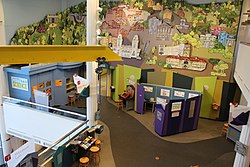EcoTarium: Difference between revisions
EcoScience (talk | contribs) m Removed Tree Canopy Walkway because it is no longer offered here and is closed |
Rescuing 2 sources and tagging 1 as dead. #IABot (v1.6.2) (Balon Greyjoy) |
||
| Line 8: | Line 8: | ||
|longitude = |
|longitude = |
||
|established = Worcester Lyceum of Natural History, 1825<br />Worcester Natural History Society, 1884<br />Worcester Science Center, 1971<br />New England Science Center, 1986<br />EcoTarium, 1998 |
|established = Worcester Lyceum of Natural History, 1825<br />Worcester Natural History Society, 1884<br />Worcester Science Center, 1971<br />New England Science Center, 1986<br />EcoTarium, 1998 |
||
<ref name="TIMELINE">http://www.ecotarium.org/about/timeline.html</ref> |
<ref name="TIMELINE">{{cite web |url=http://www.ecotarium.org/about/timeline.html |title=Archived copy |accessdate=2008-11-05 |deadurl=yes |archiveurl=https://web.archive.org/web/20081028044317/http://ecotarium.org/about/timeline.html |archivedate=2008-10-28 |df= }}</ref> |
||
|dissolved = |
|dissolved = |
||
|location = [[Worcester, Massachusetts]] |
|location = [[Worcester, Massachusetts]] |
||
| Line 30: | Line 30: | ||
==Former Exhibits== |
==Former Exhibits== |
||
Until recently, one of the museum's most well-known exhibits was a [[polar bear]] named Kenda. Kenda died June 13, 2011. Kenda had developed kidney disease (a common disease in polar bears at zoos) and it was decided that she should be euthanized. With this, polar bears are no longer able to be seen in New England. <ref>http://www.ecotarium.org/exhibitsanimals/animals/pbear</ref> Kenda's mother, Ursa Minor, lived at the museum until her death in 2001 at the age of 36, making her one of the oldest captive polar bears.<ref>http://www.ecotarium.org/ed/wildlife/aotm/archive/199912_pbear/index.html</ref> |
Until recently, one of the museum's most well-known exhibits was a [[polar bear]] named Kenda. Kenda died June 13, 2011. Kenda had developed kidney disease (a common disease in polar bears at zoos) and it was decided that she should be euthanized. With this, polar bears are no longer able to be seen in New England. <ref>{{cite web |url=http://www.ecotarium.org/exhibitsanimals/animals/pbear |title=Archived copy |accessdate=2011-06-15 |deadurl=yes |archiveurl=https://web.archive.org/web/20110828130240/http://www.ecotarium.org/exhibitsanimals/animals/pbear/ |archivedate=2011-08-28 |df= }}</ref> Kenda's mother, Ursa Minor, lived at the museum until her death in 2001 at the age of 36, making her one of the oldest captive polar bears.<ref>http://www.ecotarium.org/ed/wildlife/aotm/archive/199912_pbear/index.html{{dead link|date=January 2018 |bot=InternetArchiveBot |fix-attempted=yes }}</ref> |
||
==External links== |
==External links== |
||
Revision as of 08:10, 25 January 2018
 | |
 | |
| Established | Worcester Lyceum of Natural History, 1825 Worcester Natural History Society, 1884 Worcester Science Center, 1971 New England Science Center, 1986 EcoTarium, 1998 [1] |
|---|---|
| Location | Worcester, Massachusetts |
| Type | Science museum |
| Website | http://www.ecotarium.org |
The EcoTarium is a science and nature museum located in
History
The EcoTarium was founded in 1825 as the Worcester Lyceum of Natural History.[2] The first spaces dedicated to the museum were the Natural History Rooms on the third floor of the Worcester Bank Block on Foster Street, which opened on October 1, 1867. In 1891 the collection that started the EcoTarium moved to the Old Edwin Conant Mansion 12 State street corner of Harvard street].
As the collection grew more and more space was needed. In 1954 the museum moved exhibits to the Daniels House and the Rice House at 41 Elm street, both in Worcester. The final move took place in 1971 to a new building, designed by Edward Durell Stone, built on 60 acres (240,000 m2) of donated land. At this point the name of the museum was changed to the Worcester Science Center, then changed again in 1986 to the New England Science Center.
In 1998 the museum yet again changed its name to EcoTarium, and began an 18 million dollar expansion and renovation project which was finished in 2000. [1]
Former Exhibits
Until recently, one of the museum's most well-known exhibits was a polar bear named Kenda. Kenda died June 13, 2011. Kenda had developed kidney disease (a common disease in polar bears at zoos) and it was decided that she should be euthanized. With this, polar bears are no longer able to be seen in New England. [3] Kenda's mother, Ursa Minor, lived at the museum until her death in 2001 at the age of 36, making her one of the oldest captive polar bears.[4]
External links
References
- ^ a b "Archived copy". Archived from the original on 2008-10-28. Retrieved 2008-11-05.
{{cite web}}: Unknown parameter|deadurl=ignored (|url-status=suggested) (help)CS1 maint: archived copy as title (link) - ^ http://ecotarium.org/about/
- ^ "Archived copy". Archived from the original on 2011-08-28. Retrieved 2011-06-15.
{{cite web}}: Unknown parameter|deadurl=ignored (|url-status=suggested) (help)CS1 maint: archived copy as title (link) - ^ http://www.ecotarium.org/ed/wildlife/aotm/archive/199912_pbear/index.html[permanent dead link]
42°15′50.8″N 71°46′00.5″W / 42.264111°N 71.766806°W

